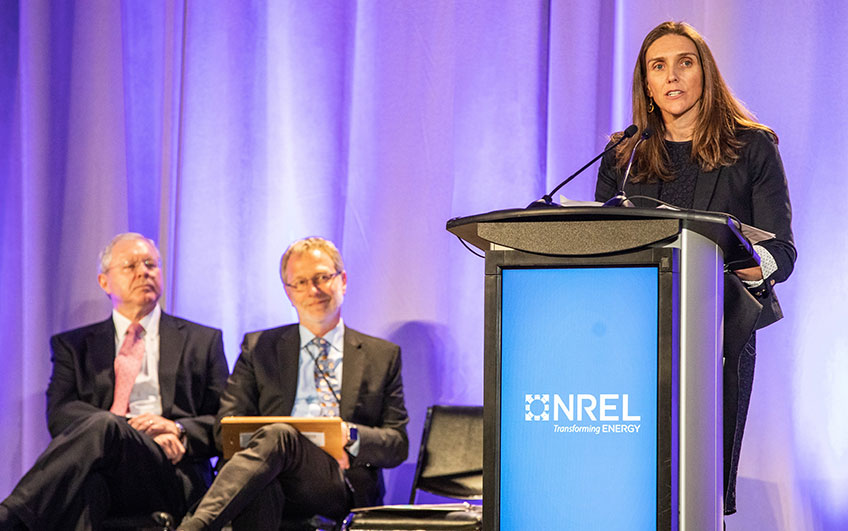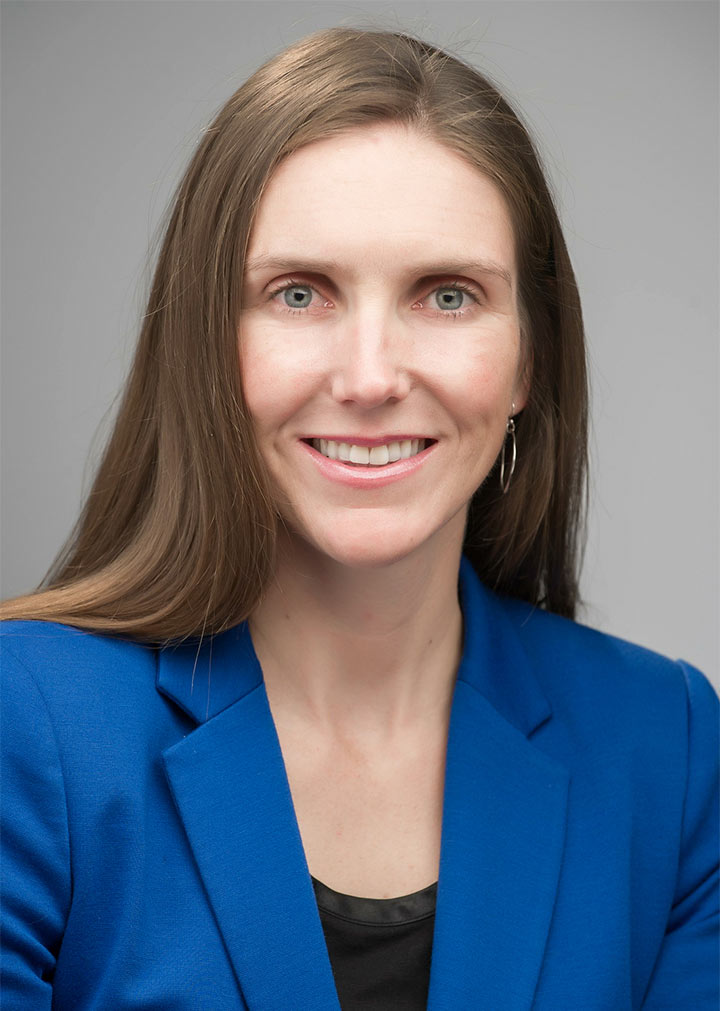Q&A with Andrea Watson: Building Teams to Solve Energy Challenges Globally

Andrea Watson leads the Integrated Decision Support group at the National Renewable Energy Laboratory (NREL). She and her team advance complex energy projects and programs that require strategy development, analytics, and technical decision-making. Watson's expertise lies in strategic planning, change strategies, and decision-making support as applied to clean energy projects and programs. Watson also leads NREL's work with the U.S. Agency for International Development (USAID), which focuses on assisting countries with policy, planning, and deployment support for advanced energy technologies.
How did your career path lead to NREL?
My first job in renewable energy was as an intern with Creative Energies, which installs off-grid renewable energy applications in remote parts of Wyoming. Before that, I was a National Outdoor Leadership School instructor, so I had a healthy appreciation for the environment. With renewable energy, I started to see where my work could make a real impact on protecting the environment and transitioning to a clean power system.

Andrea Watson, leader of the Integrated Decision Support group at NREL, also leads NREL's work with USAID, focusing on assisting countries with policy, planning, and deployment support for advanced energy technologies. Photo by Dennis Schroeder, NREL.
Later, I worked as a solar coordinator for a program in New York City funded by the Department of Energy (DOE). I assisted Con Edison in increasing photovoltaic deployment on their distribution grid. We received technical assistance from NREL, and I was introduced to some of the team here.
While working with NREL, I tried to over-deliver on everything in the hope they might notice me. Around that time, the American Recovery and Reinvestment Act came to be, NREL started hiring, and Sheila Hayter recruited me.
You were a Fulbright Scholar in Chile in 2014. What did you learn that you brought back to NREL?
Fulbright is a U.S. Department of State (DOS) program, and much of the work I do at NREL is with USAID and DOS. Many partners have backgrounds in the Peace Corps or in international development. Before Fulbright, I had not worked as a part of the diplomatic arm of the U.S. government. Gaining that perspective became very relevant to the projects I'm involved in now at NREL.
How did you come to lead NREL's partnership with USAID?
Dan Bilello and Jaquelin Cochran were two founding team members who worked with USAID directly to design how NREL could be part of the Enhancing Capacity for Low Emission Development Strategies (EC-LEDS) initiative, a whole-of-government approach to helping countries reduce greenhouse gas emissions while developing economically.
When Cochran moved on from leading the project, I stepped in. I learned how to design and scope projects, how to understand what our partner agencies are looking to accomplish, and how to determine the laboratory's role in helping partners accomplish their goals.
Building off EC-LEDS, we've developed relationships with other USAID programs, including Power Africa and USAID missions around the world. We also designed and implemented the natural continuation of our cooperation with USAID in Washington, D.C., the USAID-NREL Partnership.
What common issue do you face when leading an international strategic partnership like NREL's USAID portfolio?
One main concern is assessing NREL's role as a research laboratory and how that frames our engagement with partners. When working with partners, we must define the questions that are uniquely appropriate for NREL or other DOE laboratories to answer but that are also relevant to the needs of these countries in their energy transitions.
We cannot lead with NREL's research goals alone—what NREL might be interested in researching might not be what a country needs; however, there are many interesting research questions that are uniquely appropriate for NREL to answer about where a partner is in the energy transition and how they plan to achieve their goals. Identifying that space remains top of mind for me.
How does the USAID-NREL Partnership support the mission of the Integrated Applications Center (IAC)?
IAC is trying to answer problems people and governments have right now. That is what IAC and the USAID-NREL Partnership are all about: how we leverage NREL's cutting-edge research, development, and analysis to provide technical assistance, knowledge, and tools that help countries transition to clean energy.
The USAID-NREL Partnership is also a great example of a cross-directorate program. It draws from capabilities in multiple directorates but most heavily from Scientific Computing and Energy Analysis (SCEA) and Energy Systems Integration. Many questions we are trying to answer for our partner countries are about power sector modeling, and we work with an incredible team in the Strategic Energy Analysis Center within SCEA to deliver that expertise.
What are the most urgent energy challenges developing countries face?
One of the biggest challenges is that in order to understand that renewable energy might be the least-cost energy solution, countries must be able to model and analyze renewable energy correctly and compare it to other potential generation sources.
If a country doesn't have the data, capacity, knowledge, or analysis capability, they won't be able to assess renewable energy options correctly. They might miss the opportunity to take advantage of least-cost renewable energy options, and they might miss the opportunity to increase the resilience of their power systems and better leverage the resources within their borders.
Which projects or programs are you most excited about right now?
Within my group in IAC, I am most excited about the decision support work we are doing. We are thinking about how we can pay attention to more factors than just the results of a piece of analysis to better understand why, when, and how this technical work can directly influence decisions. This requires looking at multidisciplinary aspects of energy problems, which is a capability we already have, but growing that capability and continuing to recognize there are political and behavioral aspects as well as economic and policy drivers surrounding energy problems.
Within the USAID portfolio, it has been exciting to support the USAID Regional Development Mission for Asia (RDMA). This is a new program for NREL. I'm also excited to continue deepening our bilateral partnerships with USAID missions in places like Vietnam, Colombia, and the Philippines.
What emerging topics would you like to tackle in the future?
From the USAID-NREL Partnership perspective, we've done a great job of developing tools and platforms around grid issues and renewable energy resource data, but there is clearly demand and interest around transportation and electric vehicles. I think there is a lot more we can do to leverage our capabilities in that space, so I'm excited to explore that more in the next year.
Tell us about your sources of professional inspiration.
I care a lot about who I work for and who I work with, so I draw much of my inspiration from team members as well as mentors. I have consistently sought to surround myself with people who share my goals and care about how we do the work, not only the end results.
I'm inspired to build teams and tackle problems such that we can find solutions and make an impact that tangibly improves our world. I am grateful that NREL provides an opportunity for me to do this every day.
Last Updated May 28, 2025
